3.4 Smell, Taste, Touch: The Chemical and Skin Senses
Smell: Nosing Around
One day when Zoe was walking in the park with a friend, Liz decided to pay her an unexpected visit. As soon as her mom came within 15 feet, Zoe turned off the trail and made a beeline toward her with outstretched arms. She knew her mother had arrived because she could smell her, and she could do it while strolling through the breezy outdoors and eating a potent-smelling orange. Zoe was so confident in her sense of smell, explains Liz, “[that] she was willing to walk off the path into the grass to unknown territory, positive that’s where I was.” Either Zoe’s sense of smell is extraordinarily sharp, or she has learned to use it more effectively than the average person. Do you think your nose could accomplish the same?
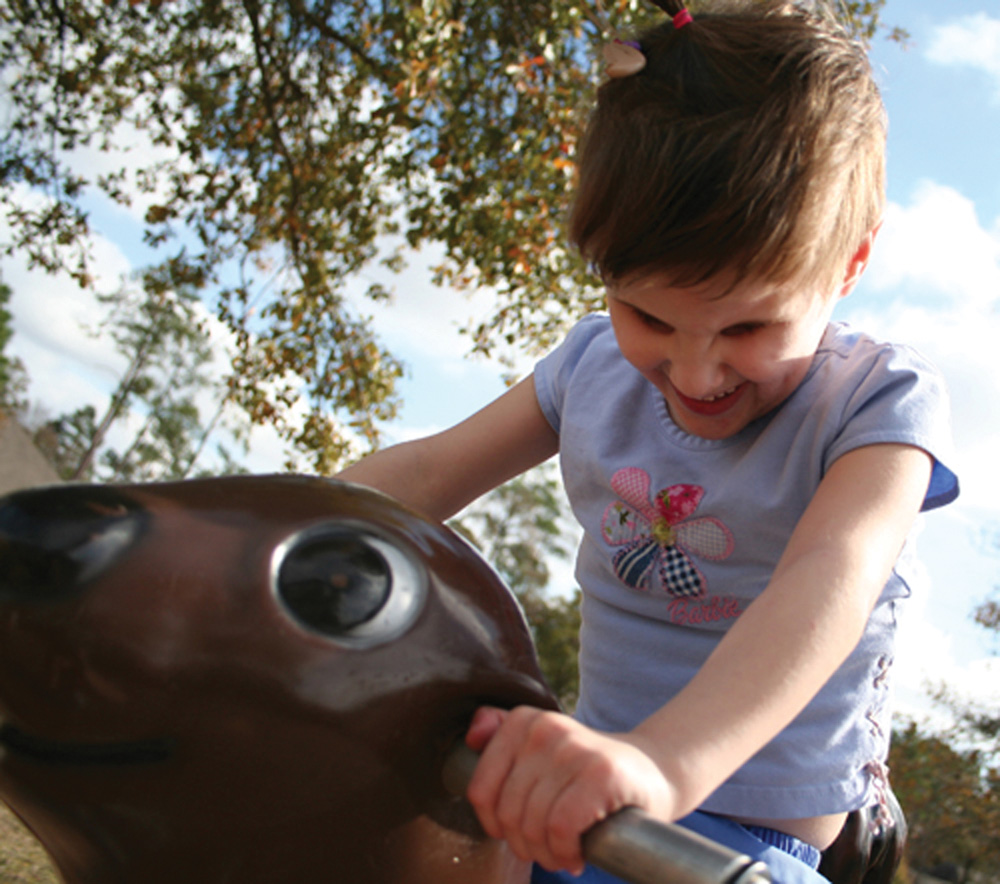
CONNECTIONS
In Chapter 2, we introduced the concept of neuroplasticity, which refers to the ability of the brain to heal, grow, and make do with what’s available. Here, we suggest that Zoe’s heavy reliance on other senses is made possible by the plasticity of her nervous system.
Olfaction
LO 9 Describe the process of olfaction.
Many people take olfaction (ōl-′fak-shən)—the sense of smell—for granted. But such individuals might think twice if they actually understood how losing olfaction would affect their lives. People with the rare condition of anosmia are unable to perceive odors. They cannot smell smoke in a burning building or a gas leak from a stove. They cannot tell whether the fish they are about to eat is spoiled. Nor can they savor the complex palates of pesto, curry, chocolate, coffee, or prime rib. Because, without smell, food doesn’t taste as good.
Chemical Sense
Olfaction and taste are called chemical senses, because they involve sensing chemicals in the environment. For olfaction, those chemicals are odor molecules riding currents of air. For taste, they are flavor molecules surfing on waves of saliva. Odor molecules, which are emitted by a variety of sources (for example, spices, fruits, flowers, bacteria, and skin), make their way into the nose by hitchhiking on currents of air flowing into the nostrils or through the mouth. About 3 inches into the nostrils is a patch of tissue called the olfactory epithelium. Around the size of a typical postage stamp, the olfactory epithelium is home to millions of olfactory receptor neurons that provide tiny docking sites, or receptors, for odor molecules (much as a lock acts as a docking site for a key; Figure 3.3). When enough odor molecules attach to an olfactory receptor neuron, it fires, causing an action potential, illustrating how transduction occurs in the chemical sense of olfaction.
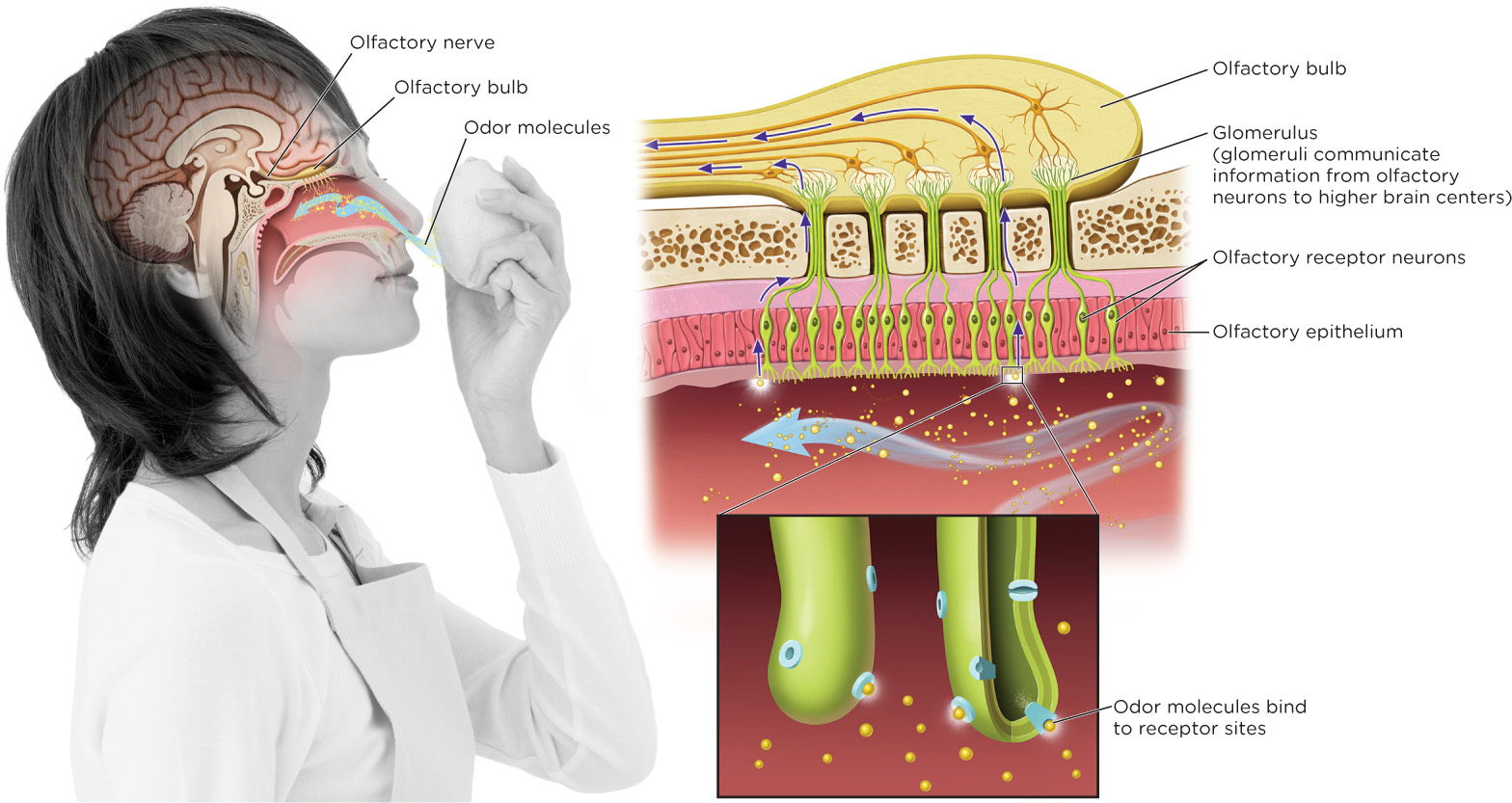
CONNECTIONS
In Chapter 2 we discussed the properties that allow neurons to communicate with other cells. When sending neurons signal a receiving neuron to pass along its message, their combined signal becomes excitatory and the neuron will fire. Here we are discussing olfactory receptor neurons stimulated by odor molecules. If enough odor molecules are present, an action potential occurs, causing a spike in electrical energy to pass through the axon.
Olfaction and The Brain
Olfactory receptor neurons stimulate a part of the brain called the olfactory bulb, with similar neurons converging in clusters called glomeruli (Figure 3.3). Then the signal is passed along to higher brain centers, including the hippocampus, amygdala, and olfactory cortex (Firestein, 2001). The other sensory systems relay data through the thalamus before going to higher brain centers. But the wiring of the olfactory system is unique; olfaction is on a fast track to the limbic system, where emotions like fear and anger are processed.
Olfactory Receptors
There is another reason smell is special. Olfactory receptor neurons are one of the few types of neurons that regenerate. Once an olfactory receptor neuron is born, it does its job for a minimum of 30 days, then dies and is replaced (Schiffman, 1997). This process slows with age, impairing odor sensitivity (Larsson, Finkel, & Pedersen, 2000). If it weren’t for this continual replenishment of olfactory neurons, we wouldn’t smell much of anything. Olfactory neurons are in direct contact with the environment, so they are constantly under assault by bacteria, dirt, and noxious chemicals. Some toxins—like the fumes and dust at New York City’s World Trade Center site after the terrorist attacks in 2001—can even cause long-term damage to the olfactory system. Many workers involved in the clean-up effort following 9/11 may be permanently impaired in their ability to smell (Dalton et al., 2010).
Humans have about 350 different types of odor receptors, yet we can distinguish over 10,000 different odors (Buck, 2004). Each receptor type recognizes several odors, and each odor activates several receptors; a given scent creates a telltale pattern of electrical activity that the brain recognizes as lemon, garlic, or smelly feet. The types of receptors and the degree to which they are activated identify the odor (Firestein, 2001). Our sense of smell may be keen, but it pales in comparison to that of some dogs, who can detect millions of odors. Humans can discriminate thousands of different odors, yet we may have trouble naming them (Schmidt & Cain, 2010).
Scents have a powerful influence on human behavior and thought. Within minutes after birth, babies use the scent of their mother’s breast to guide them toward the nipple, and they quickly learn to discriminate Mom’s milk from someone else’s (Makin & Porter, 1989; Porter & Winberg, 1999). Research also suggests that odor-induced memories are not necessarily more accurate than those evoked by touching, hearing, or seeing something (Herz, 1998), but they are more emotional and “associated with stronger feelings of being brought back in time” (Larsson & Willander, 2009, p. 318). Why are memories triggered by smell so drenched in emotion? Remember that olfactory information is communicated directly to the limbic system. Evidence suggests that smells activate this emotion-processing hub more than other sensations. Brain imaging research indicates smelling a perfume remembered from one’s past activates the amygdala more than looking at its bottle (Herz, 2007; Herz, Eliassen, Beland, & Souza, 2004).
Given the power of scent, it is no surprise people become attached to certain perfumes and scented body products. But would you believe smells are capable of cultivating more positive reactions to entire stores and other commercial entities? This is what scent marketers are hoping.
didn’t SEE that coming
The Scent of Money
 Next time you pass by an upscale hotel, walk into the lobby and perk up your nose. You may catch wind of lavender, white tea, or citrus. Hotel chains are among the many commercial establishments now using “scent marketing” to allure customers. Sony Style uses hints of orange, vanilla, and cedar; and Las Vegas casinos such as the Mirage have been piping odors through their gambling halls since the 1990s, apparently in an attempt to drive up customer satisfaction and boost revenues (Rosenblum, 2010; Vlahos, 2007, September 9). But what does the science say?
Next time you pass by an upscale hotel, walk into the lobby and perk up your nose. You may catch wind of lavender, white tea, or citrus. Hotel chains are among the many commercial establishments now using “scent marketing” to allure customers. Sony Style uses hints of orange, vanilla, and cedar; and Las Vegas casinos such as the Mirage have been piping odors through their gambling halls since the 1990s, apparently in an attempt to drive up customer satisfaction and boost revenues (Rosenblum, 2010; Vlahos, 2007, September 9). But what does the science say?

Some research suggests that ambient odors can sway customer perceptions of stores and products. In one study, clothing store shoppers were more satisfied with their experience and spent more money when ambient scents were “gender congruent.” Men reacted more positively when the store smelled “masculine” (like rose maroc) as opposed to “feminine” (vanilla), and women reacted more positively when the store smelled feminine (Spangenberg, Sprott, Grohmann, & Tracy, 2006). Another study found that diffusing an orange essence through the waiting room of a dental office reduced patients’ anxiety and lightened their moods (Lehrner, Eckersberger, Walla, Pötsch, & Deecke, 2000).
DOES THIS MARKETING STRATEGY SMELL?
Researchers are still trying to determine the extent to which aromas and other sensory stimuli affect the numbers, but it’s probably safe to say that no aroma, no matter how luscious and enticing, will force you to squander your hard-earned cash.
Taste: Just Eat It
Your sense of smell may not affect your shopping habits, but it definitely impacts your culinary preferences. Eating is as much an olfactory experience as it is a taste experience. Just think back to the last time your nose was clogged from a really bad cold. How did your meals taste? When you chew, odors from the food float up into your nose, creating a flavor that you perceive as “taste,” when it’s actually smell. If this mouth–nose connection is blocked, there is no difference between apples and onions, Sprite and Coke, or wine and cooled coffee (Herz, 2007). Don’t believe us? Then do the Try This experiment.
try this
Tie on a blindfold, squeeze your nostrils, and ask a friend to hand you a wedge of apple and a wedge of onion, both on toothpicks so that you can’t feel their texture. Now bite into both. Without your nose, you probably can’t tell the difference (Rosenblum, 2010).
Gustation
LO 10 Discuss the structures involved in taste and describe how they work.
If the nose is so crucial for flavor appreciation, then what role does the mouth play? Receptors in the mouth are sensitive to five basic but very important tastes: sweet, salty, sour, bitter, and umami. You are likely familiar with all these tastes, except perhaps umami, which is a savory taste found in seaweed, aged cheeses, protein-rich foods, mushrooms, and monosodium glutamate (MSG; Chandrashekar, Hoon, Ryba, & Zuker, 2006). We call the ability to detect these stimuli our sense of taste, or gustation (gəs-′t-shən; Figure 3.4).
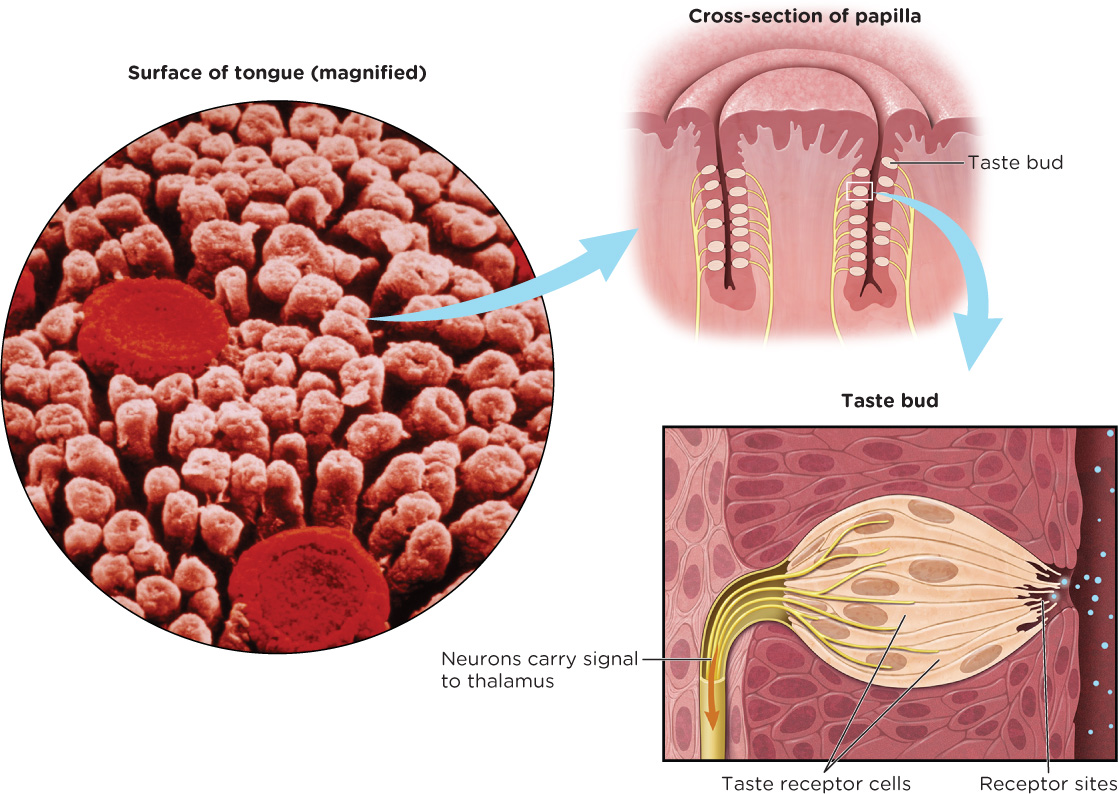
Chemical Sense
Receptor cells for taste are found in the taste buds on the tongue, the roof of the mouth, and lining the cheeks. Somewhere between 5,000 to 10,000 taste buds are embedded in the papillae, those bumps you can see on a person’s tongue (Society for Neuroscience, 2012). Jutting from each of these buds are 50 to 100 taste receptor cells, and it is onto these cells that taste molecules bind (similar to the lock-and-key mechanism of an odor molecule binding to a receptor in the nose).
As you bite into a juicy orange and begin to chew, chemicals from the orange (sour acid and sweet sugar) are released into your saliva, where they dissolve and bathe the taste buds throughout your mouth. The chemicals find their way to matching receptors and latch on, sparking action potentials in sensory neurons, another example of transduction. Signals are then sent through sensory neurons to the thalamus, and then on to higher brain centers for processing.
CONNECTIONS
In Chapter 2, we learned that sensory neurons receive information from the sensory system and send it to the brain for processing. With gustation, the sensory neurons are sending information about taste. Once processed in the brain, information can be sent back through motor neurons signaling you to take another bite!
Receptors for taste are constantly being replenished; but their life span is only about 10 days (Schiffman, 1997). If they didn’t regenerate, you would be in trouble every time you burned your tongue sipping hot coffee or eating hot soup. By age 20, you have already lost half of the taste receptors you had at birth. And as the years go by, their turnover rate gets slower and slower, making it harder to appreciate the basic taste sensations (Kaneda et al., 2000). Drinking alcohol and smoking worsen the problem by impairing the ability of receptors to receive taste molecules. Losing taste is unfortunate, and it may take away from life’s simple pleasures, but it’s probably not going to kill you—at least not if you are a modern human. But we can’t be so sure about our primitive ancestors.
Evolution and Taste

Taste has been essential to the survival of our species. Tastes push us toward foods we need and away from those that could harm us. We gravitate toward sweet, calorie-rich foods for their life-sustaining energy—an adaptive trait if you are a primitive human foraging in trees and bushes, not so adaptive if you are a modern human looking for something to eat at the food court in your local shopping mall. We are also drawn to salty foods, which tend to contain valuable minerals, and umami, which signals the presence of proteins essential for cellular health and growth. Bitter and sour tastes we tend to avoid, on the other hand. This also gives us an evolutionary edge because poisonous plants or rancid foods are often bitter and sour. And it is interesting to note that our absolute threshold for bitter is lower than the threshold for sweet. Can you see how this is advantageous to us?
In addition to evolutionary advantages, there are individual preferences. You like cilantro; your friend thinks it tastes like bath soap. Taste preferences may begin developing before birth, as flavors consumed by a pregnant woman pass into amniotic fluid and are swallowed by the fetus. Research suggests this early exposure shapes taste preferences later in life. For example, infants who were exposed in utero to the flavor of carrots (through their mothers’ consumption of carrot juice in the last trimester) showed fewer disapproving facial expressions when fed carrot-flavored cereal compared to plain cereal. This suggests exposure to the carrot flavor before birth led to greater enjoyment of this taste compared to that of plain cereal. This taste preference was not evident in infants who had not been exposed to the flavor of carrots in utero (Mennella, Coren, Jagnow, & Beauchamp, 2001).
We have made some major headway in this chapter, examining four of the major sensory systems: vision, hearing, smell, and taste. Now it is time to get a feel for a fifth sense. Are you ready for tingling, tickling, and titillating touch?
Touch: Feel the Magic
If you were introduced to Zoe, she would probably explore your face for about 20 seconds, and then return to what she was doing. Emma would likely spend more time getting to know you. She might give you a hug, put her cheek against yours, and carefully explore your head with her fingers. Emma pores over things, paying close attention to detail. Zoe moves fast and focuses on the goal.

At the dinner table, Emma is neat and tidy, and does not like to get food on her hands and face. Zoe loves to dig in and make a mess. These two girls, who are genetically identical, experience the world of touch in dramatically different ways. But both rely on touch receptors that dwell within the body’s main touch organ—the skin.
Your Epidermis is Showing
Take a moment to appreciate your vast epidermis, the outer layer of your skin. Weighing around 6 pounds on the average adult, the skin is the body’s biggest organ and the barrier that protects our insides from cruel elements of the environment (bacteria, viruses, and physical objects) and distinguishes us from others (fingerprints, birth marks). It also shields us from the cold, sweats to cool us down, and makes vitamin D (Bikle, 2004). And perhaps most importantly, skin is a data collector. Every moment of the day, receptors in our skin gather information about the environment. Among them are thermoreceptors that sense hot or cold, Pacinian corpuscles that detect vibrations, and Meissner’s corpuscles sensitive to the slightest touch, like a snowflake landing on your nose (Bandell, Macpherson, & Patapoutian, 2007; Figure 3.5).
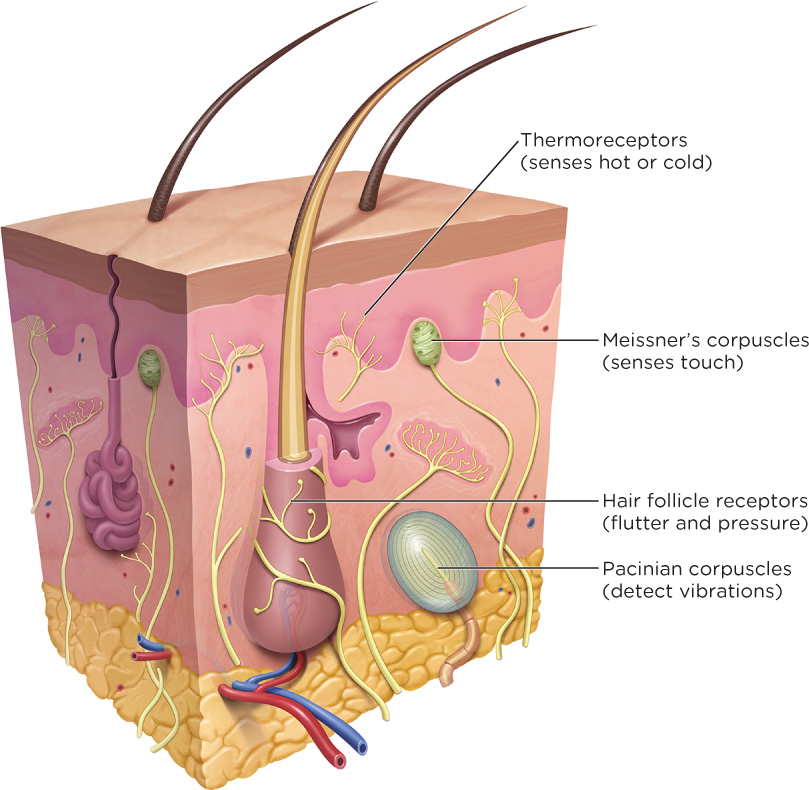
Oh, the Pain
Not all touch sensations are as pleasant as the tickle of a snowflake. Touch receptors can also communicate signals that are interpreted as pain. Nociceptive pain is caused by heat, cold, chemicals, and pressure. Nociceptors that respond to these stimuli are primarily housed in the skin, but they also are found in muscles and internal organs.
Speaking of temperature, have you ever experienced a brief, piercing headache immediately after gulping down ice cream? What is this brain freeze, and why does it happen?
from the pages of SCIENTIFIC AMERICAN
Brain Freeze Explained
Cold drinks cause a major artery in the skull to dilate.
Ice cream headache is a familiar summertime sensation, but the pain’s source has been mysterious until now. A team led by Jorge Serrador of Harvard Medical School produced brain scans of “second-by-second changes” in blood flow while subjects sipped iced water through a straw pressed against the roof of the mouth, which caused the brain’s major artery to widen. “Blood flow changes actually preceded the pain” that subjects reported, Serrador says. As the vessel narrowed again, the discomfort ebbed. He suspects that the influx of blood is meant to protect the brain from extreme cold and that increased pressure inside the skull could cause the pain. Serrador presented the results at Experimental Biology 2012 in April in San Diego. Stephani Sutherland. Reproduced with permission. Copyright © 2012 Scientific American, a division of Nature America, Inc. All rights reserved.
Can’t Feel Pain
In very rare cases, some children are born without the ability to feel pain. Children with this type of genetic disorder are potentially at greater risk of serious injury (Romero, Simón, Garcia-Recuero, & Romance, 2008). Not knowing they have been hurt, some scrapes and cuts might go unnoticed and untreated. Pain protects us from minor bangs and bruises as well as serious bodily harm. The “ouch” that results from the stub of a toe or the prick of a needle tells us to stop what we are doing and tend to our wounds. Let’s find out how this protective mechanism works.
Two Pathways for Pain
Thanks to the elaborate system of nerves running up and down our bodies, we are able to experience unpleasant, yet very necessary, sensations of pain. Fast nerve fibers, made up of large, myelinated neurons, are responsible for conveying information about pain occurring in the skin and muscles, generally experienced as a stinging feeling in a specific location. If you stub your toe, your first perception is a painful sting where the impact occurred. Slow nerve fibers, made up of smaller, unmyelinated neurons, are responsible for conveying information about pain throughout the body. Pain conveyed by the slow nerve fibers is more like a dull ache, not necessarily located in a specific region. After the immediate sting of stubbing your toe, you might feel a more diffuse aching in that area, due to slow nerve fibers. As the names of these fibers suggest, fast nerve fibers convey information quickly (at a speed of 30–110 meters/sec) and slow nerve fibers convey information more slowly (8–40 meters/sec; Somatosensory Function, 2004). But where are they sending this information?
CONNECTIONS
In Chapter 2, we explained how a myelin sheath insulates the axon and speeds up the conduction of electrical impulses. The myelin covering the fast nerve fibers allows them to convey their information about pain more quickly than the slow nerve fibers that are unmyelinated.
The axons of these fast and slow sensory nerve fibers band together as nerves on their way to the spinal cord and up to the brain (Figure 3.6). The bundled fast nerve fibers make their way to the reticular formation of the brain, alerting it that something important has happened. The information then goes to the thalamus and on to the somatosensory cortex, where sensory information from the skin is processed further (for example, indicating where it hurts most). The bundled slow nerve fibers start out in the same direction toward the brain, with processing occurring in the brainstem, the hypothalamus, thalamus, and limbic system. In the midbrain and amygdala, for example, emotional reactions to the pain are processed (Gatchel, Peng, Peters, Fuchs, & Turk, 2007). As with other neurons, the transmission of information about pain occurs through electrical and chemical activities. Substance P and glutamate are two important neurotransmitters that work together to increase the firing of the pain fibers at the injury location.
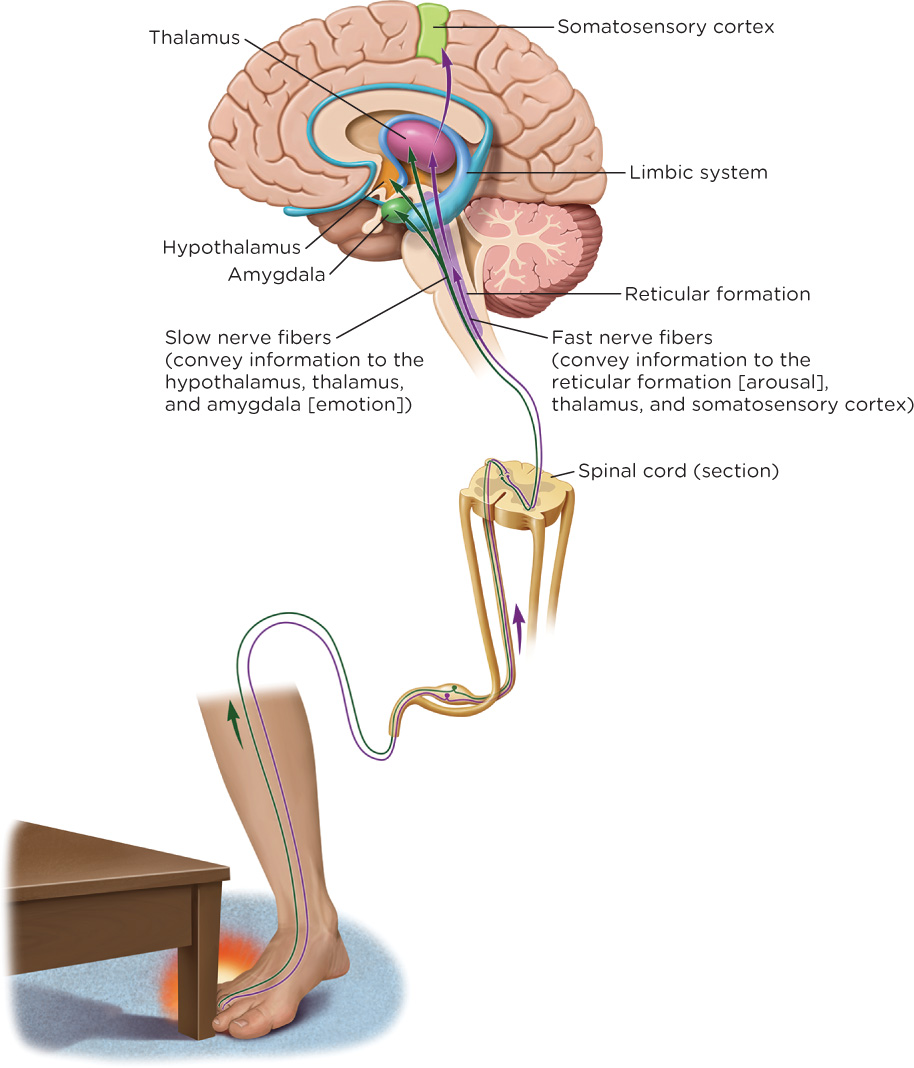
Just knowing the mechanisms at the neural level does not explain how we perceive pain and why our experiences of pain are so varied. A bump on the head that causes one person to shriek in agony may not faze someone else. No two people experience pain exactly the same way.
LO 11 Describe how the biopsychosocial perspective is used to understand pain.
As with most complex topics in psychology, we need to explore the phenomenon of pain using a multilevel method, such as the biopsychosocial perspective. Chronic pain can be explained by biological factors (the neurological pathways involved), psychological factors (distress, cognition), and social factors (immediate environment, relationships; Gatchel et al., 2007). Prior experiences, environmental factors, and cultural expectations influence how the pain is processed (Gatchell & Maddrey, 2004).
Researchers studying pain initially tried to find a direct path from pain receptors to specific locations in the brain, but this simple relationship does not exist (Melzack, 2008). Instead, there is a complex interaction between neurological pathways and psychological and social factors, and a gate involved in the shuttling of information back and forth between the brain and the rest of the body.
Gate Control
The most influential theory of pain perception is the gate-control theory. Melzack and Wall (1965) proposed that a person’s perception of pain is either increased or decreased by how the brain interprets pain through an interaction of biopsychosocial factors. Once pain messages are received in the brain (through the mechanisms outlined above), the brain interprets the incoming information, and then sends signals back down through the spinal cord to either open or close the “gates” that control the neurological pathways for pain. Depending on the situation, psychological factors, and social influences, the gates will open, to increase the experience of pain, or close, to decrease the experience of pain. The gates might be instructed to close in situations when it’s important to keep going in spite of an injury (athletes in competitions, soldiers in danger). This “close the gate” message can happen with distractions, which interfere with the ability to attend to pain, causing the pain to be perceived as less intense. Or the gates might be instructed to remain open, for example, when it is important for pain to be felt intensely (when you are ill, and your body needs to rest).
Signals to shut the gate do not always come from the brain (Melzack, 1993, 2008). Information sent from the pain receptors in the body can also open and close the neurological gates from the bottom-up, depending on which type of fiber is active. If the small unmyelinated fibers are active, the gates are more likely to open, sending the pain message up the spinal cord to the brain. If the large myelinated fibers are active, the gates are more likely to close, inhibiting pain messages from being sent on. Suppose you stub your toe. One way to ease the pain is by rubbing the injured area, stimulating the pressure receptors of the large fibers. This activity closes the gates, interfering with the pain message that would have been sent to the brain.
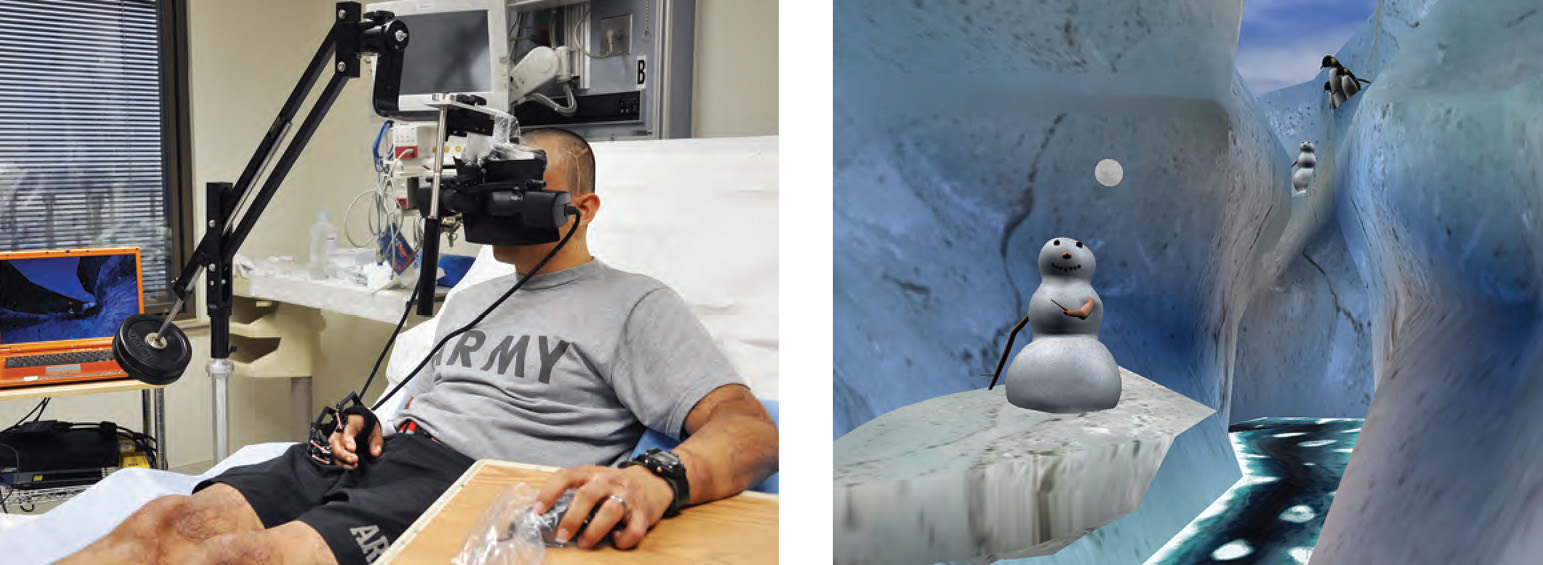
It is clear that everyone experiences pain in a unique way. But are there factors that predispose a person to be more or less sensitive to pain?
The Psychology of Pain
Pain sensitivity can ebb and flow for an individual, with psychological factors exerting a powerful effect (Gatchel et al., 2007; Raichle, Hanley, Jensen, & Cardenas, 2007). Negative feelings such as fear and anxiety can amplify pain, whereas laughter and distraction can soften it. Certain types of stress (for example, running in a marathon, giving birth) trigger the release of endorphins. Endorphins reduce pain by blocking the transmission of pain signals to the brain and spinal cord, possibly through the inhibition of substance P, a neurotransmitter in the spinal cord and brain (Rosenkranz, 2007).
CONNECTIONS
In Chapter 2, we reported that endorphins are naturally produced opioids that regulate the secretion of other neurotransmitters.
As you can see, pain is a complex psychological phenomenon, dependent on many factors beyond the initial stimulus—so complex that a stimulus may not even be necessary. Can you imagine feeling a piercing burn or a stabbing cramp in a leg that you don’t even have?
Phantom Limb Pain
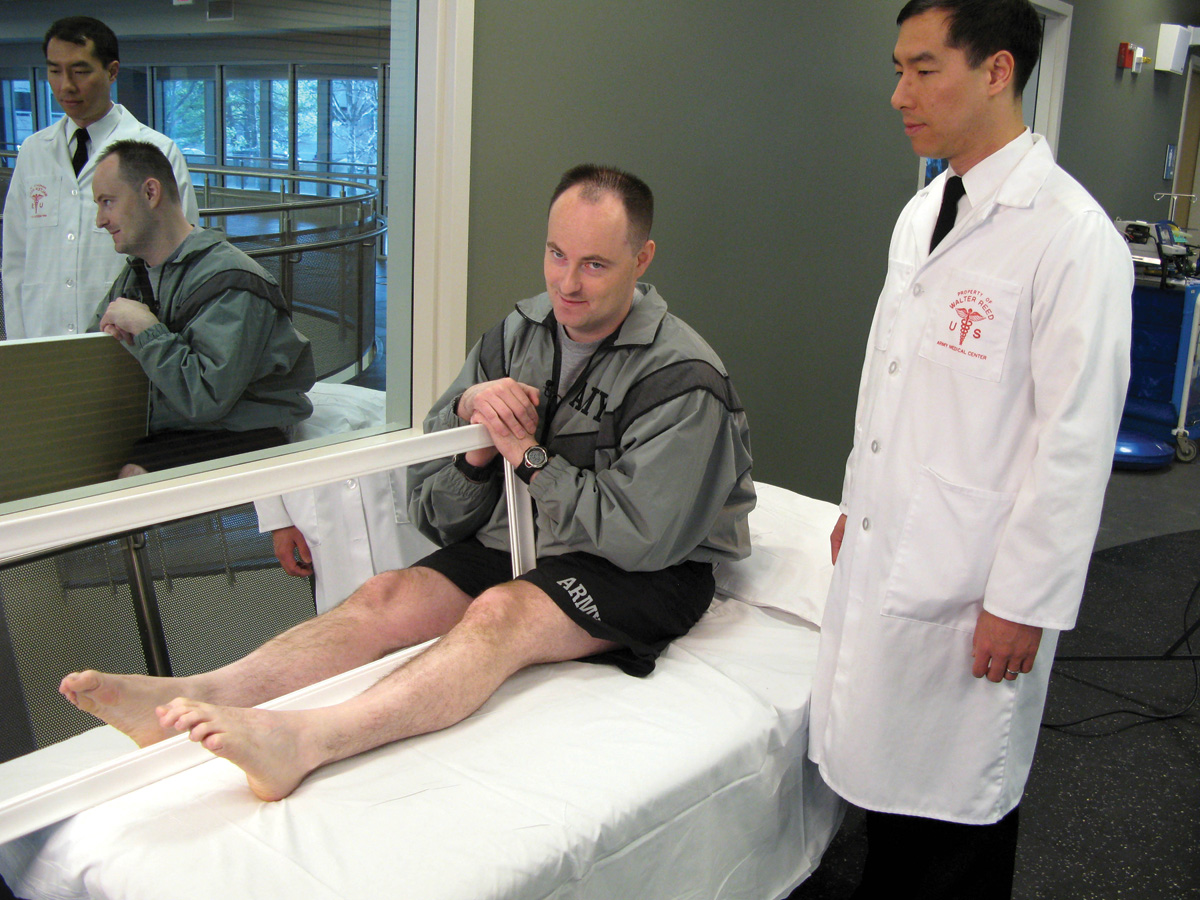
Sometimes people who have had an arm or leg amputated experience intense pain in their missing limb. Phantom limb pain occurs in 50–80% of people who have lost a limb through amputation, with reports of burning, tingling, cramping, and sharp feelings in the missing appendage (Ramachandran & Brang, 2009; Ramachandran & Hauser, 2010). One phantom limb sufferer reported feeling a burning itch in the place where his big toe used to be; to relieve the itch, he would scratch the air there (Rosenblum, 2010). Why amputees are haunted by their lost limbs is not entirely clear, and there are a variety of suggested mechanisms underlying this type of pain, ranging from changes in the structure of neurons to reorganization of the brain in relation to sensations felt in different locations in the body (Flor, Nikolajsen, & Jensen, 2006). When the brain doesn’t receive normal signals from the limb, conflicting messages are sent to the brain from nerve cells and seem to be interpreted as pain.
Kinesthesia
LO 12 Illustrate how we sense the position and movement of our bodies.
You may have thought “touch” was the fifth and final sense, but there is more to sensation and perception than the traditional five categories. Closely related to touch is the sense of kinesthesia (ki-nəs-′thē-zhē-ə), which provides feedback to us about body position and movement. Kinesthesia endows us with the coordination we need to walk without stumbling, dance the salsa, and put on our clothes without looking in the mirror. This knowledge of body location and orientation is made possible by specialized nerve endings called proprioceptors (proh-pree-uh-sep-t rs), which are primarily located in the muscles and joints. Proprioceptors monitor changes in the position of body parts and the tension in muscles. So as you are trying to dance, your proprioceptors are gathering information about where your right foot is in relation to your right knee, where your left arm is in relation to your head, allowing you to dance like a professional. When proprioception is impaired, the ability to do things like hold a book, walk without falling over, or drive is impacted.
Vestibular Sense
You may recall from earlier in the chapter that Emma, Zoe, and Sophie began to curl up in the fetal position and vomit while riding in the car during the same period that they lost their hearing. This was because they were losing their vestibular sense (ve-′sti-byə-lər), which helps the body deal with the effects of gravity, movement, and position and which gives us the information we need to feel balanced and to be balanced. Astronauts often become nauseated during their first days in space because their vestibular systems are confused. The vestibular system comprises fluid-filled organs located in the inner ear: the semicircular canals and the nearby vestibular sacs. When the head tilts, fluid moves the hairlike receptors in these structures, causing neurons to fire, sending messages to the cerebellum (transduction once again). Motion sickness, which many people experience on boats and roller coasters, is caused by conflicting information we receive from our eyes and from our vestibular systems. This is known as sensory conflict theory (Johnson, 2005).

We have made it through a long and challenging lesson on sensation. The senses we have explored enable us to see the intricate details of a painted masterpiece, hear cries of sorrow and joy, and feel the warm sand as we walk along the beach smelling the salty water. But how do simple sensations turn into perceptions that have meaning?
show what you know
Question 3.12
1. The chemical sense called __________ provides the sensation of smell.
olfaction
Question 3.13
2. Chemicals from food that is being eaten are released in saliva, where they dissolve and bathe the taste buds in your mouth. The chemicals find matching receptors and latch on, sparking action potentials. This is an example of:
- olfaction.
- transduction.
- sensory adaptation.
- thermoreceptors.
b. transduction.
Question 3.14
3. Describe the common features and characteristics of smell, taste, and touch.
Smell, taste, and touch all include the sensing of information in the environment through receptor cells designed to detect a particular kind of stimuli. These three senses also involve transduction, which is the process of transforming stimuli into neural signals. Neural signals for all three of these senses then are processed by the central nervous system. Smell and taste are considered chemical senses, as they both involve sensing chemicals (odor molecules for olfaction, flavor molecules for taste) in the environment. Taste and touch relay data through the thalamus before going to higher brain centers, whereas olfaction is not relayed through the thalamus.
Question 3.15
4. Maya consulted her physician about severe back pain. In order to help her understand pain perception, her doctor recommended she consider __________, which suggests that the interpretation of pain can either increase or decrease the perception of pain through an interaction of biopsychosocial factors.
- the theory of evolution
- an absolute threshold
- the gate-control theory
- gustation
c. the gate-control theory